方位的表达法
- 格式:ppt
- 大小:876.00 KB
- 文档页数:26
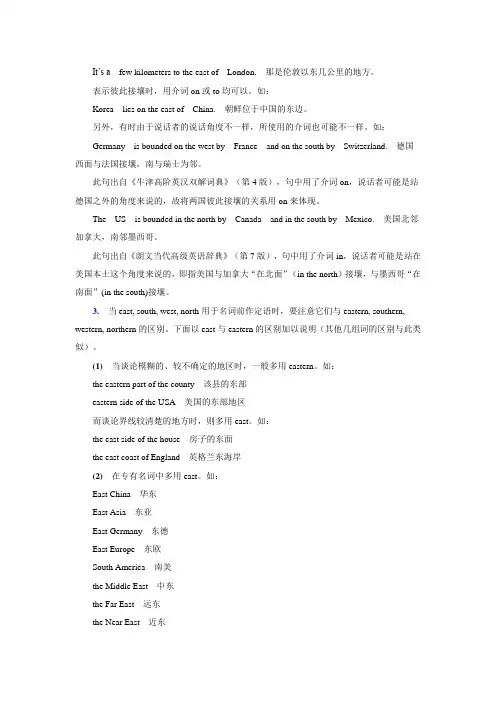
谈谈north, south, east and west(北、南、东、西)的用法英语中表示方位的东、西、南、北四个名词是east, west, south和north。
在使用时要注意以下几点:1.在通常情况下,其前要加定冠词。
如:The sun rises in the east and sets in the west.太阳从东方升起,至西方落下。
Better farmlands lie in the north of the state.肥沃的农田分布在该国北部。
The north is less expensive to live in than the south.北方的生活费用比南方低。
Go toward the south to get to Mexico from Texas.向南走从德克萨斯州进入墨西哥。
但是,当强调方位对比时,可以不用冠词。
如:South is opposite north on a compass.罗盘上南与北相对。
The direction opposite to north is south.北的反方向是南。
East or west, home is best.东好西好不如自己的家好。
有时表示纯方位,也可不用冠词。
如:I’m lost—which way is east?我迷路了,哪边是东?另外,与from…to…连接的两个表示方位的名词,其前通常也不用冠词。
如:The river flows from north to south.这条河从北向南流。
2.表示“在……的东(南、西、北)”,通常应根据具体情况来选用介词。
(1)以下各例的方位名词前用介词in,表示一地在另一地的范围之内。
如:China is in the east of Asia.中国位于亚洲的东部。
The church is located in the east of the city.教堂在本市的东部。

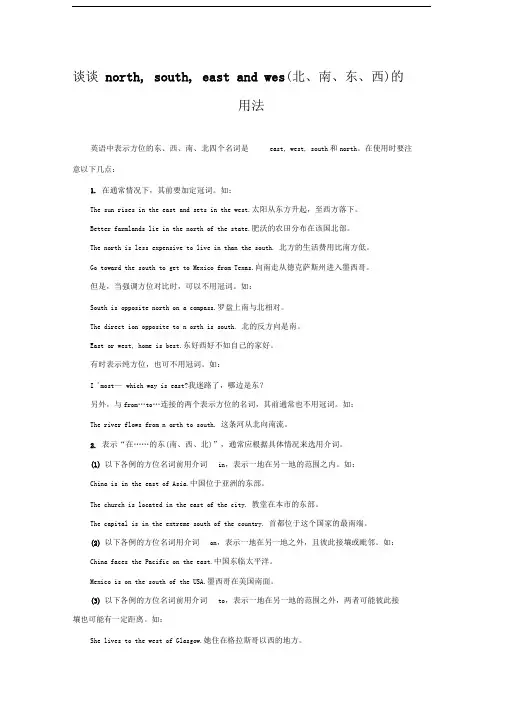
谈谈north, south, east and wes(北、南、东、西)的用法英语中表示方位的东、西、南、北四个名词是east, west, south和north。
在使用时要注意以下几点:1.在通常情况下,其前要加定冠词。
如:The sun rises in the east and sets in the west.太阳从东方升起,至西方落下。
Better farmlands lie in the north of the state.肥沃的农田分布在该国北部。
The north is less expensive to live in than the south. 北方的生活费用比南方低。
Go toward the south to get to Mexico from Texas.向南走从德克萨斯州进入墨西哥。
但是,当强调方位对比时,可以不用冠词。
如:South is opposite north on a compass.罗盘上南与北相对。
The direct ion opposite to n orth is south. 北的反方向是南。
East or west, home is best.东好西好不如自己的家好。
有时表示纯方位,也可不用冠词。
如:I 'm ost—which way is east?我迷路了,哪边是东?另外,与from…to…连接的两个表示方位的名词,其前通常也不用冠词。
如:The river flows from n orth to south. 这条河从北向南流。
2.表示“在……的东(南、西、北)”,通常应根据具体情况来选用介词。
(1)以下各例的方位名词前用介词in,表示一地在另一地的范围之内。
如:China is in the east of Asia.中国位于亚洲的东部。
The church is located in the east of the city. 教堂在本市的东部。
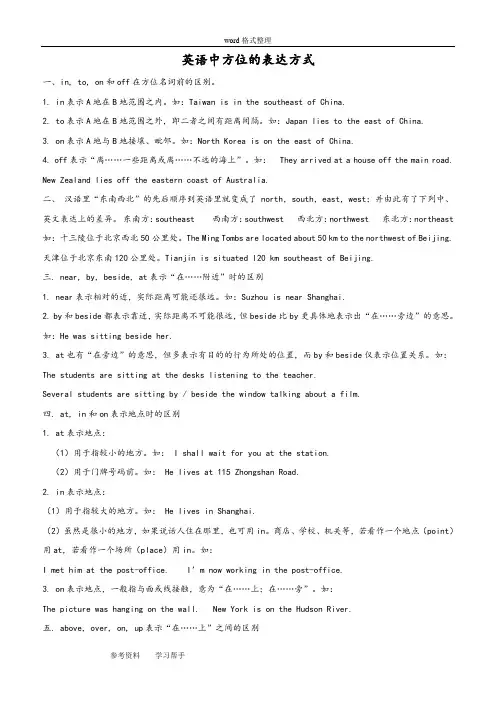
英语中方位的表达方式一、in, to, on和off在方位名词前的区别。
1. in表示A地在B地范围之内。
如:Taiwan is in the southeast of China.2. to表示A地在B地范围之外,即二者之间有距离间隔。
如:Japan lies to the east of China.3. on表示A地与B地接壤、毗邻。
如:North Korea is on the east of China.4. off表示“离……一些距离或离……不远的海上”。
如: They arrived at a house off the main road. New Zealand lies off the eastern coast of Australia.二、汉语里“东南西北”的先后顺序到英语里就变成了north,south,east,west;并由此有了下列中、英文表达上的差异。
东南方:southeast 西南方:southwest 西北方:northwest 东北方:northeast 如:十三陵位于北京西北50公里处。
The Ming Tombs are located about 50 km to the northwest of Beijing.天津位于北京东南120公里处。
Tianjin is situated l20 km southeast of Beijing.三. near, by, beside, at表示“在……附近”时的区别1. near表示相对的近,实际距离可能还很远。
如:Suzhou is near Shanghai.2. by和beside都表示靠近,实际距离不可能很远,但beside比by更具体地表示出“在……旁边”的意思。
如:He was sitting beside her.3. at也有“在旁边”的意思,但多表示有目的的行为所处的位置,而by和beside仅表示位置关系。
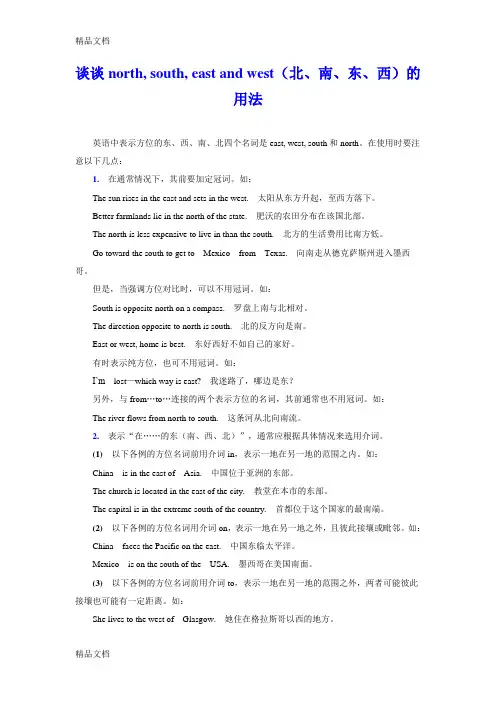
谈谈north, south, east and west(北、南、东、西)的用法英语中表示方位的东、西、南、北四个名词是east, west, south和north。
在使用时要注意以下几点:1.在通常情况下,其前要加定冠词。
如:The sun rises in the east and sets in the west.太阳从东方升起,至西方落下。
Better farmlands lie in the north of the state.肥沃的农田分布在该国北部。
The north is less expensive to live in than the south.北方的生活费用比南方低。
Go toward the south to get to Mexico from Texas.向南走从德克萨斯州进入墨西哥。
但是,当强调方位对比时,可以不用冠词。
如:South is opposite north on a compass.罗盘上南与北相对。
The direction opposite to north is south.北的反方向是南。
East or west, home is best.东好西好不如自己的家好。
有时表示纯方位,也可不用冠词。
如:I’m lost—which way is east?我迷路了,哪边是东?另外,与from…to…连接的两个表示方位的名词,其前通常也不用冠词。
如:The river flows from north to south.这条河从北向南流。
2.表示“在……的东(南、西、北)”,通常应根据具体情况来选用介词。
(1)以下各例的方位名词前用介词in,表示一地在另一地的范围之内。
如:China is in the east of Asia.中国位于亚洲的东部。
The church is located in the east of the city.教堂在本市的东部。
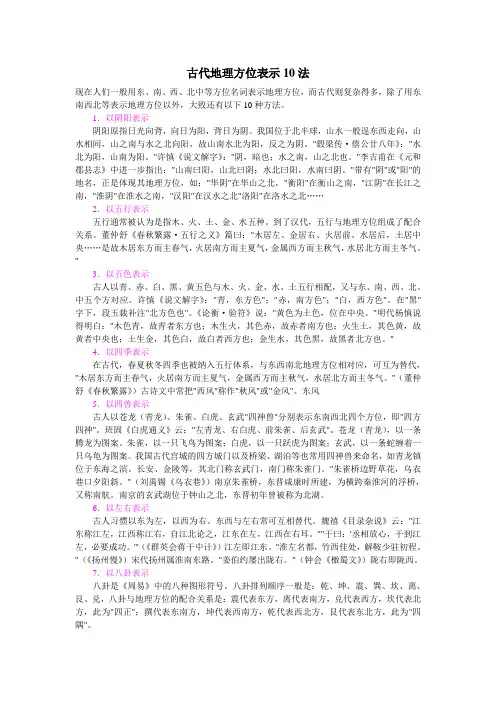
古代地理方位表示10法现在人们一般用东、南、西、北中等方位名词表示地理方位,而古代则复杂得多,除了用东南西北等表示地理方位以外,大致还有以下10种方法。
1.以阴阳表示阴阳原指日光向背,向日为阳,背日为阴。
我国位于北半球,山水一般逞东西走向,山水相间,山之南与水之北向阳,故山南水北为阳,反之为阴。
"毂梁传·僖公廿八年》:"水北为阳,山南为阳。
"许慎《说文解字》:"阴,暗也;水之南,山之北也。
"李吉甫在《元和郡县志》中进一步指出:"山南曰阳,山北曰阴;水北曰阳,水南曰阴。
"带有"阴"或"阳"的地名,正是体现其地理方位,如:"华阴"在华山之北,"衡阳"在衡山之南,"江阴"在长江之南,"淮阴"在淮水之南,"汉阳"在汉水之北"洛阳"在洛水之北……2.以五行表示五行通常被认为是指木、火、土、金、水五种。
到了汉代,五行与地理方位组成了配合关系。
董仲舒《春秋繁露·五行之义》篇曰:"木居左、金居右、火居前、水居后,土居中央……是故木居东方而主春气,火居南方而主夏气,金属西方而主秋气,水居北方而主冬气。
"3.以五色表示古人以青、赤、白、黑、黄五色与木、火、金、水、土五行相配,又与东、南、西、北、中五个方对应。
许慎《说文解字》:"青,东方色";"赤,南方色";"白,西方色"。
在"黑"字下,段玉裁补注"北方色也"。
《论衡·验符》说:"黄色为土色,位在中央。
"明代杨慎说得明白:"木色青,故青者东方也;木生火,其色赤,故赤者南方也;火生土,其色黄,故黄者中央也;土生金,其色白,故白者西方也;金生水,其色黑,故黑者北方也。

谈谈north, south, east and wes(北、南、东、西)的用法英语中表示方位的东、西、南、北四个名词是east, west, south和north。
在使用时要注意以下几点:1.在通常情况下,其前要加定冠词。
如:The sun rises in the east and sets in the west.太阳从东方升起,至西方落下。
Better farmlands lie in the north of the state.肥沃的农田分布在该国北部。
The north is less expensive to live in than the south. 北方的生活费用比南方低。
Go toward the south to get to Mexico from Texas.向南走从德克萨斯州进入墨西哥。
但是,当强调方位对比时,可以不用冠词。
如:South is opposite north on a compass.罗盘上南与北相对。
The direct ion opposite to n orth is south. 北的反方向是南。
East or west, home is best.东好西好不如自己的家好。
有时表示纯方位,也可不用冠词。
如:I 'm ost—which way is east?我迷路了,哪边是东?另外,与from…to…连接的两个表示方位的名词,其前通常也不用冠词。
如:The river flows from n orth to south. 这条河从北向南流。
2.表示“在……的东(南、西、北)”,通常应根据具体情况来选用介词。
(1)以下各例的方位名词前用介词in,表示一地在另一地的范围之内。
如:China is in the east of Asia.中国位于亚洲的东部。
The church is located in the east of the city. 教堂在本市的东部。
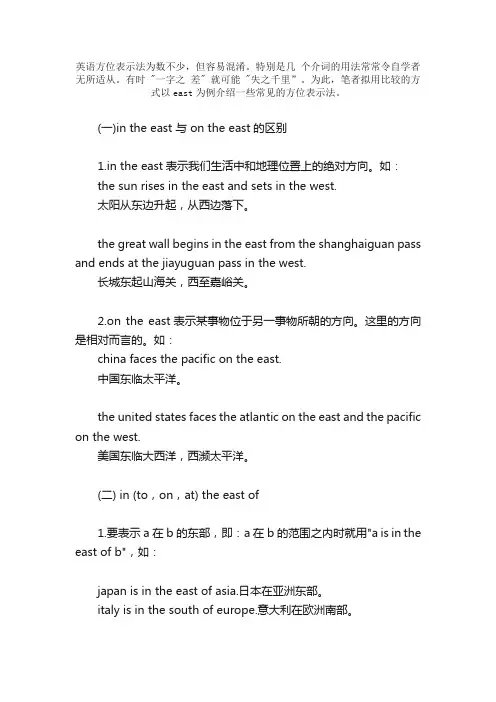
英语方位表示法为数不少,但容易混淆。
特别是几个介词的用法常常令自学者无所适从。
有时 "一字之差" 就可能 "失之千里”。
为此,笔者拟用比较的方式以east为例介绍一些常见的方位表示法。
(一)in the east 与 on the east的区别1.in the east表示我们生活中和地理位置上的绝对方向。
如:the sun rises in the east and sets in the west.太阳从东边升起,从西边落下。
the great wall begins in the east from the shanghaiguan pass and ends at the jiayuguan pass in the west.长城东起山海关,西至嘉峪关。
2.on the east表示某事物位于另一事物所朝的方向。
这里的方向是相对而言的。
如:china faces the pacific on the east.中国东临太平洋。
the united states faces the atlantic on the east and the pacific on the west.美国东临大西洋,西濒太平洋。
(二) in (to,on,at) the east of1.要表示a在b的东部,即:a在b的范围之内时就用"a is in the east of b",如:japan is in the east of asia.日本在亚洲东部。
italy is in the south of europe.意大利在欧洲南部。
2.如果a在b的东方,即:a在b的范围之外,且相隔有一定的距离,就用"a lies to the east of b".口语中有时可将to the省去。
如:japan lies (to the) east of china.日本位于中国东方。
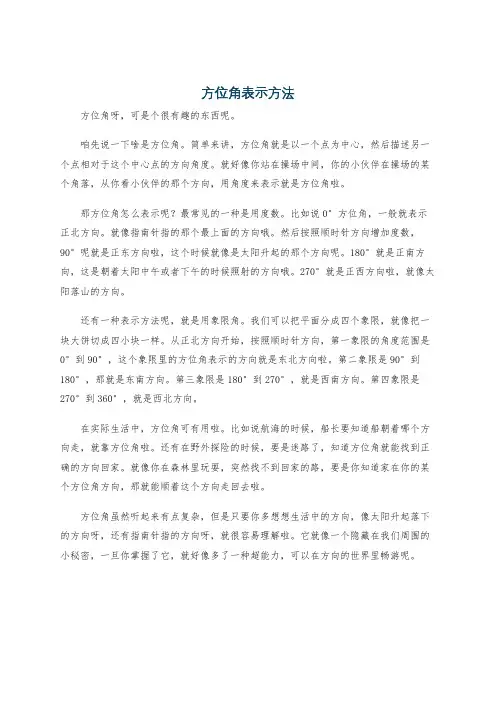
方位角表示方法方位角呀,可是个很有趣的东西呢。
咱先说一下啥是方位角。
简单来讲,方位角就是以一个点为中心,然后描述另一个点相对于这个中心点的方向角度。
就好像你站在操场中间,你的小伙伴在操场的某个角落,从你看小伙伴的那个方向,用角度来表示就是方位角啦。
那方位角怎么表示呢?最常见的一种是用度数。
比如说0°方位角,一般就表示正北方向。
就像指南针指的那个最上面的方向哦。
然后按照顺时针方向增加度数,90°呢就是正东方向啦,这个时候就像是太阳升起的那个方向呢。
180°就是正南方向,这是朝着太阳中午或者下午的时候照射的方向哦。
270°就是正西方向啦,就像太阳落山的方向。
还有一种表示方法呢,就是用象限角。
我们可以把平面分成四个象限,就像把一块大饼切成四小块一样。
从正北方向开始,按照顺时针方向,第一象限的角度范围是0°到90°,这个象限里的方位角表示的方向就是东北方向啦。
第二象限是90°到180°,那就是东南方向。
第三象限是180°到270°,就是西南方向。
第四象限是270°到360°,就是西北方向。
在实际生活中,方位角可有用啦。
比如说航海的时候,船长要知道船朝着哪个方向走,就靠方位角啦。
还有在野外探险的时候,要是迷路了,知道方位角就能找到正确的方向回家。
就像你在森林里玩耍,突然找不到回家的路,要是你知道家在你的某个方位角方向,那就能顺着这个方向走回去啦。
方位角虽然听起来有点复杂,但是只要你多想想生活中的方向,像太阳升起落下的方向呀,还有指南针指的方向呀,就很容易理解啦。
它就像一个隐藏在我们周围的小秘密,一旦你掌握了它,就好像多了一种超能力,可以在方向的世界里畅游呢。

方位表达法一、表示走法1.turn left 左转turn right 右转2.go along …road/street 沿着…路/街走3.go/walk across…bridge/square 穿过…桥/广场4.go straight ahead/ go straight on 向前直走5.go past 走过,路过二、表示方位1.next to 挨着2.over there 在那边right here 就在这儿3.You are standing here 你现在在这儿start here 从这儿开始走4.on the left 在左边on the right 在右边5.opposite 在对面,相对的6.between…and…在…和…之间7.on the corner of 在转角处,在角落里8.on the corner of A road and B road 在A街和B街的转角处9.into+…street/road 进入…街三、标志物1.traffic lights 交通灯,红绿灯2.cross 十字路口四、问路的句型1.Excuse me, where is…?2.Can you tell me how do I get to…?3.Could you tell me the way to…please?五、建筑名称bank 银行bookshop 书店market 市场supermarket 超市park 公园square 广场swimming pool 游泳池restaurant 饭店tower 塔bridge 桥church 教堂store 商店palace 宫殿museum 博物馆gallery 美术馆parliament 国会hall 大厅,大堂方位表达法一、表示走法6.turn left 左转turn right 右转7.go along …road/street 沿着…路/街走8.go/walk across…bridge/square 穿过…桥/广场9.go straight ahead/ go straight on 向前直走10.go past 走过,路过二、表示方位10.next to 挨着11.over there 在那边right here 就在这儿12.You are standing here 你现在在这儿start here 从这儿开始走13.on the left 在左边on the right 在右边14.opposite 在对面,相对的15.between…and…在…和…之间16.on the corner of 在转角处,在角落里17.on the corner of A road and B road 在A街和B街的转角处18.into+…street/road 进入…街三、标志物3.traffic lights 交通灯,红绿灯4.cross 十字路口四、问路的句型1.Excuse me, where is…?2.Can you tell me how do I get to…?3.Could you tell me the way to…please?五、建筑名称bank 银行bookshop 书店market 市场supermarket 超市park 公园square 广场swimming pool 游泳池restaurant 饭店tower 塔bridge 桥church 教堂store 商店palace 宫殿museum 博物馆gallery 美术馆parliament 国会hall 大厅,大堂。

方位角表示法一、方位角的定义1. 在人教版教材中,方位角是从某点的指北方向线起,依顺时针方向到目标方向线之间的水平夹角。
例如,以A点为观测点,B点位于A点的东偏北30°方向,这里的东偏北30°就是一个方位角。
1. 方位角的取值范围- 方位角的取值范围是0°到360°。
例如,正北方向的方位角为0°(或者360°,这两种表示在方位角概念中是等同的),正东方向的方位角为90°,正南方向为180°,正西方向为270°。
2. 方位角的表示形式- 通常用“×偏×”的形式来表示。
- 以观测点为中心,先确定是东、西、南、北四个基本方向中的哪一个作为起始方向(靠近目标方向的那个基本方向),然后再说明偏离这个基本方向多少度。
- 例如,北偏东30°,表示从正北方向开始,顺时针旋转30°到达目标方向;南偏西45°,表示从正南方向开始,顺时针旋转45°到达目标方向。
3. 在实际应用中的表示- 在航海中,船舶的航向就是用方位角来表示的。
一艘船的航向为120°,这就表示船的行驶方向是南偏东60°(因为120° - 90°=30°,90° - 30° = 60°,即相对于正南方向向东偏离了60°)。
- 在测量中,确定一个地点相对于另一个地点的方向时,也会用到方位角。
例如,测量点A到点B的方位角为210°,这意味着从A点看B点是南偏西30°(210°-180° = 30°)。
英语方位词above ,at ,behind ,below ,beside ,between ,in front of, in the ifront of ,next to,on opposite ,outside ,over ,under . 英语方位表示法为数不少,但容易混淆。
特别是几个介词的用法常常令自学者无所适从。
有时"一字之差" 就可能"失之千里”。
为此,下列用比较的方式以east 为例介绍一些常见的方位表示法。
(一)in the east 与on the east 的区另1.in the east 表示我们生活中和地理位置上的绝对方向。
如:The sun rises in the east and sets in the west. 太阳从东边升起,从西边落下。
The Great Wall begins in the east from the Shanghaiguan Pass and ends at the Jiayuguan Pass in the west.长城东起山海关,西至嘉峪关。
2.on the east 表示某事物位于另一事物所朝的方向。
这里的方向是相对而言的。
如:China faces the Pacific on the east.中国东临太平洋。
The United States faces the Atlantic on the east and the Pacific on the west. 美国东临大西洋,西濒太平洋。
(二)in (to,on,at) the east of1. 要表示A在B的东部,即: A在B的范围之内时就用"A is in the east of B", 如:Japan is in the east of Asia. 日本在亚洲东部。
Italy is in the south of Europe. 意大利在欧洲南部。
英语“方位”表示法in the east 与on the east的区别1.in the east表示我们生活中和地理位置上的绝对方向。
如:The sun rises in the east and sets in the west.太阳从东边升起,从西边落下。
The Great Wall begins in the east from the Shanghaiguan Pass and ends at the Jiayuguan Pass in the west.长城东起山海关,西至嘉峪关。
2.on the east表示某事物位于另一事物所朝的方向。
这里的方向是相对而言的。
如:China faces the Pacific on the east.中国东临太平洋。
The United States faces the Atlantic on the east and the Pacific on the west.美国东临大西洋,西濒太平洋。
in the east of1.要表示A在B的东部,即:A在B的范围之内时就用A is in the east of B,如:Japan is in the east of Asia.日本在亚洲东部。
Italy is in the south of Europe.意大利在欧洲南部。
2.如果A在B的东方,即:A在B的范围之外,且相隔有一定的距离,就用A lies to the east of B。
口语中有时可将to the省去。
如:Japan lies east of China.日本位于中国东方。
France lies east of England.法国位于英国东方。
3.如果A在B的东边,即:A与B相邻接。
就用A is on the east of B。
如:Guangdong is on the south of Hunan.广东在湖南南边。
Shangdong is on the north of Jiangsu.山东在江苏北边。
方向的三种表达方式
在我们的日常生活中,我们经常需要描述或指示方向。
为了做到这一点,我们可以使用多种不同的方法。
以下是描述和指示方向的三种主要表达方式。
1. 方位词表达法:
方位词是描述物体相对于观察者位置的词汇。
例如,"前"、"后"、"左"、"右"、"上"、"下"等。
这些词可以帮助我们在二维或三维空间中定位一个物体。
比如,当你告诉别人“书店在你的左边”,你就是用方位词来描述了书店的位置。
2. 东、南、西、北(地理坐标)表达法:
这是最常用的方向表达方式之一,尤其是在户外或驾驶时。
通过使用地理坐标系统,我们可以准确地确定一个地方的地理位置。
例如,“图书馆在北方,离这里大约两公里”。
3. 利用地标性建筑或地点表达法:
这种方法是利用周围环境中的标志性建筑或地点来描述方向。
例如,你可以这样描述:“走过公园,你会看到一个红色的房子,那就是你要找的地方。
”这种方法尤其适用于城市环境中,因为城市中有许多明显的地标可以作为参照点。
以上就是描述和指示方向的三种主要表达方式。
每种方式都有其独特的优势,选择哪种方式取决于具体情况和个人偏好。
无论你是在城市还是乡村,熟悉并掌握这些表达方式都能帮助你更好地导航和沟通。
方位角的表示方法方位角是表示物体相对地球坐标系的位置方式,可以用来确定一个物体位于地球表面上的具体位置。
它是由地心坐标系确定,它可以使用纬度、经度和高度来表示一个地球上的点。
一般情况下,这种表示方式只用于确定地面物体的位置,尤其是对于比较大的地方,如大城市,河流等。
方位角一般用经度和纬度来表示,经度是指以等距线为基础的地球表面的经度线,它将地球分为南北半球,以及东西两个方向。
经度的值通常以度为单位,从0°至180°,东为正,西为负。
纬度是指以等经线为基础的地球表面的纬度线,它将地球分成东西半球,以及南北两个方向。
纬度的值通常以度为单位,从0°至90°,南为正,北为负。
此外,还有一种表示方位角的方法,叫做“方位角”。
方位角是指从一个点出发,沿着旋转的方向画出一个圆,然后以此点为圆心画出第二个圆,而这两个圆上的点就是方位角。
这种方式精确地表示了一个点的位置,它可以用来定位船只、飞机等物体在地球表面上的位置。
方位角的表示通常用度来标记,它的值从0°至360°,以正北为基准,顺时针表示。
方位角的表示通过度度角和方位角两种方式可以准确地表示一个地球上的点。
它们可以被用来确定一个物体在地球表面上的位置,因此,它们在航海、航空、航天等领域都有着重要的用途。
除了度度角和方位角,还有一种表示物体在地球上的位置的方法,叫做“地心坐标系”。
它采用的坐标系是以地球的中心为原点,以南北纬度线和东西经度线构成的,用来表示南北纬度、东西经度和地球的高度。
地心坐标系一般应用于航海、航空、航天等领域,其中最重要的是“大圆”和“小圆”。
大圆和小圆都是由经线和纬线构成的,它们可以用来精确地描述一个地面物体的位置,而这进一步可以用来确定物体的位置。
总的来说,方位角的表示方法可以准确地表示地球上的一个点,它们可以用来定位物体,特别是在航海、航空、航天等领域有着非常重要的作用。
如今,它也被广泛应用于航海测量、航空航天定位、地理信息系统等多种领域,发挥着重要的作用。